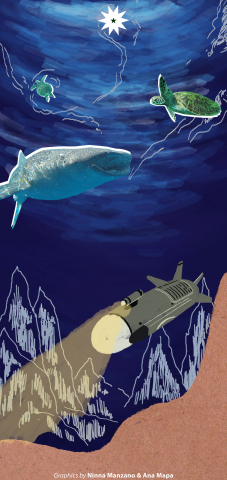Despite comprising more than 70 percent of Earth’s surface, the majority of the planet’s oceans remain unexplored. From undiscovered species, and undersea geology such as subduction zones and brine pools, to unexplainable mysteries such as the sunken city of Pavlopetri, and the 52 hertz blue whale, the opportunities for discovery are missed as long as what lies deep beneath the surface remains unknown.
However, the term “deep sea” often brings about misunderstandings, as the average depth of the entirety of Earth’s oceans is about 3.5 kilometers (km) from the surface. This means that majority of the planet is in deep sea, as Challenger Deep is measured to be 11 km from the surface—making it the deepest point in our oceans.
Uncharted
While satellites have enabled scientists to plot the ocean floor based on how water flows above undersea features like mountains or ridges, more than 80 percent of the ocean floor remains unmapped.
Similar to people needing maps to travel on land, expeditions that reach the deeper parts of the oceans—all the way to the deepest trenches known as hadal regions, referencing the Greek god Hades—can allow mankind to discover possible routes to take when traversing greater depths, as well as to identify what organisms and life forms reside in these uncharted waters.
Scientists and oceanographers are able to rely on technologies like SONAR—short for Sound Navigation and Ranging—to map the ocean floor. First developed in 1915, SONAR uses sound propagation and reflection to navigate deep underwater, and find organisms and rock formations.
This technology is mainly used for mapping and it is utilized in two different ways: multibeam SONAR, which measures the depths of the oceans based on how long it takes for the sound to travel after reflecting off a surface and returning back; and side scan SONAR, which instead determines what the ocean floor is made up of based on how intensely the scanned area reflects sound.
At present, the international community is working together to have the ocean floor fully mapped through Seabed 2030, an international project whose goal is to combine all available bathymetric data, or data containing information on the depths and shapes of underwater terrain, to produce a definitive map of the Earth’s ocean floor by the year 2030. Launched at the United Nations Ocean Conference in June 2017, the project is in line with Sustainable Development Goal 14, Life Below Water, which aims to conserve and sustainably use the seas, oceans, and marine resources.
Within the Philippines, the National Mapping and Resource Information Authority is responsible for conducting hydrographic surveys—which measure the physical features of bodies of water and those of adjacent land areas—and bathymetric surveys, as well as coordinating with any bathymetric projects by local, international, and corporate partners such as EGS Asia Inc. and BlueNomads.org Inc.
More than just a difficult task
Discovering more about the ocean floor and what knowledge it holds is not as simple as taking satellite images of Earth’s land area and organisms. However, the main reason why large swathes of the ocean floor remain in the dark is not due to any lack of initiative, funding, or technology, but because of the inherent difficulty of the task.
In an interview with The LaSallian, Br. Alfred Shields FSC Ocean Research Center (SHORE) Director Dr. Wilfredo Licuanan reveals that a deep sea exploration project in the Philippine Rise has been ongoing for three years now.
Licuanan points out that for a three-week research cruise, the fuel alone would cost over a P1-million, not including the price of boat rentals and the crew’s wages. However, the SHORE director cites that recent work involving deep sea expeditions are funded by the Department of Science and Technology and the Department of Environmental and Natural Resources to further support investments in Marine Science.
Aside from the costs, he mentions that another hindrance to deep sea explorations is the needed equipment. “We can do shallow work because [self-contained underwater breathing apparatuses are] available. But for greater depths, you need ROVs or remotely-operated vehicles—the equivalent of drones underwater,” he explains.
Despite the difficulties, these expeditions are crucial to understanding the effects of ocean warming on wildlife—which may also explain what happens after shallow water coral reefs are lost. Licuanan speculates, “The theory, or expectation at least, is that the shallow water reefs are replenished by organisms that can take refuge in the deeper waters…[which] are cooler.”
Stepping into the light
“Because the discipline is so young locally, most of the work done”—by marine biologists, physical and chemical oceanographers, and geological oceanographers—“is figuring out what lies there, what species there are, how abundant they are, and how they are distributed,” Licuanan explains. As we slowly take steps in uncovering what lay hidden in the deep hadal regions of Earth’s oceans, there is no doubt that future discoveries will further advancements in Science, with adventures bringing light to the dark watery depths.

